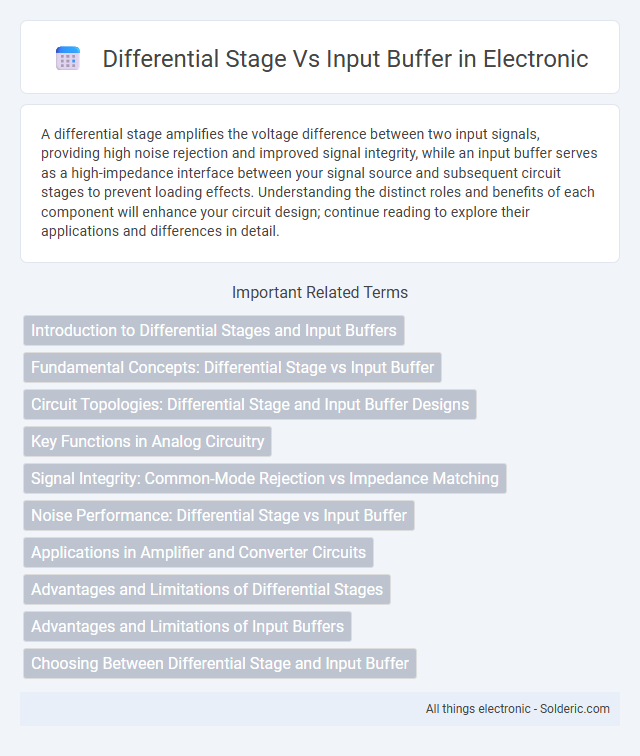A differential stage amplifies the voltage difference between two input signals, providing high noise rejection and improved signal integrity, while an input buffer serves as a high-impedance interface between your signal source and subsequent circuit stages to prevent loading effects. Understanding the distinct roles and benefits of each component will enhance your circuit design; continue reading to explore their applications and differences in detail.
Comparison Table
| Feature | Differential Stage | Input Buffer |
|---|---|---|
| Purpose | Amplifies voltage difference between two inputs | Provides high input impedance and isolates circuit |
| Input Type | Differential inputs (two signals) | Single-ended input signal |
| Gain | High gain, typically adjustable | Unity gain (buffer) |
| Impedance | High input impedance differential pair | Very high input impedance |
| Output | Amplified differential output | Buffered output matching input voltage |
| Common Applications | Operational amplifiers, mixers, ADC front-ends | Signal isolation, preventing loading effects |
| Noise Performance | Low noise due to differential rejection of common mode | Minimal noise added; preserves input integrity |
Introduction to Differential Stages and Input Buffers
Differential stages enhance signal integrity by amplifying the difference between two input signals while rejecting common-mode noise, critical in analog circuit design for improved accuracy. Input buffers serve as isolators, providing high input impedance to prevent loading effects and preserving signal fidelity when interfacing sensitive sources with subsequent circuit stages. Both components are fundamental in mixed-signal systems, ensuring robust signal conditioning and stable performance across varying input conditions.
Fundamental Concepts: Differential Stage vs Input Buffer
A differential stage amplifies the voltage difference between two input signals, enhancing noise rejection and improving signal integrity in analog circuits, while an input buffer provides impedance matching and isolates the signal source from the subsequent circuit, preserving signal strength and stability. The differential stage is essential for precision amplification tasks, especially in operational amplifiers, whereas the input buffer is primarily used to protect sensitive inputs and prevent signal degradation. Understanding these fundamental concepts helps you select the correct stage for optimizing circuit performance based on signal requirements.
Circuit Topologies: Differential Stage and Input Buffer Designs
Differential stage circuit topologies typically use pair transistors to amplify the difference between two input signals, providing higher noise immunity and better linearity compared to single-ended input buffers. Input buffer designs often employ voltage follower configurations to provide high input impedance and drive capability without signal inversion, preserving signal integrity for subsequent stages. Your choice between differential stage and input buffer topologies depends on requirements for noise rejection, gain, and input impedance in the intended application.
Key Functions in Analog Circuitry
The differential stage amplifies the voltage difference between two input signals, providing high gain and improved noise rejection in analog circuits. The input buffer isolates the input source from the rest of the circuit, ensuring signal integrity and preventing loading effects that could distort your measurements. Together, these components enhance signal quality and accuracy in precision analog applications.
Signal Integrity: Common-Mode Rejection vs Impedance Matching
Differential stages enhance signal integrity by maximizing common-mode rejection, effectively minimizing noise and interference that affect both input lines equally, which is critical in high-speed or noisy environments. Input buffers prioritize impedance matching to maintain signal amplitude and reduce reflections at the interface, ensuring accurate signal transmission in sensitive analog circuits. Your choice depends on whether your application demands robust noise immunity or precise signal amplitude preservation.
Noise Performance: Differential Stage vs Input Buffer
The differential stage offers superior noise performance compared to the input buffer by effectively rejecting common-mode noise and reducing interference through balanced signal processing. Input buffers, while simpler, tend to introduce more noise due to single-ended operation and lower common-mode rejection ratio (CMRR). Your choice should weigh the noise immunity benefits of differential stages when precision and signal integrity are critical.
Applications in Amplifier and Converter Circuits
Differential stages are critical in amplifier and converter circuits for enhancing signal integrity by rejecting common-mode noise and improving linearity, making them ideal for precise measurement and communication systems. Input buffers provide high input impedance and isolate the input signal from circuit loading, ensuring signal fidelity in ADCs and DACs by minimizing distortion and preserving voltage levels. You benefit from combining differential stages with input buffers to optimize performance in high-precision amplifiers and converters, achieving better accuracy and noise immunity.
Advantages and Limitations of Differential Stages
Differential stages offer superior noise rejection and increased signal integrity due to their inherent common-mode noise cancellation, making them ideal for precision amplification in analog circuits. They provide high gain and better linearity but require careful matching of transistor pairs and a higher power consumption compared to input buffers. Limitations include increased complexity and sensitivity to component mismatches, which can degrade performance if not properly managed.
Advantages and Limitations of Input Buffers
Input buffers provide voltage level translation and isolation between signal sources and subsequent circuitry, enhancing signal integrity in mixed-signal environments. They offer high input impedance and low output impedance, which improves noise immunity and reduces signal distortion but may introduce propagation delay and increased power consumption. Input buffers are limited in handling differential signals directly, making them less suitable for applications requiring high common-mode noise rejection compared to differential stages.
Choosing Between Differential Stage and Input Buffer
Choosing between a differential stage and an input buffer depends on the specific application requirements, such as signal integrity, noise rejection, and bandwidth. A differential stage excels in applications demanding high common-mode noise rejection and precise signal amplification, while an input buffer offers high input impedance and minimal signal loading for sensitive sources. Evaluating factors like source impedance, signal amplitude, and desired frequency response is critical for optimal circuit performance.
Differential stage vs Input buffer Infographic

 solderic.com
solderic.com